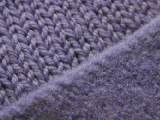

Tips and Tricks for Successful Felting
Tip 1: Not All Wools will Felt
The best wools for felting are Merino and Debouillet, followed closely by Comeback, Cormo, and Rambouillet. Longwools do not felt nearly as well.
If you are restricted to commercial yarns that don't specify the exact breed, don't fret. There are many excellent commercial yarns for felting, which we'll examine in detail next week.
"Superwash" or any other machine-washable wools have been specially treated so they won't felt when placed in the washing machine. This is good news for your sweaters and socks, but bad news for felting. Likewise, the presence of any synthetics in the yarn impedes the felting process. However, other natural fibers such as mohair and alpaca will felt beautifully.
Tip 2: Take Care in Planning Gauge and Size
Fibers need ample room to work themselves together, so you'll need to knit at a significantly looser gauge than you normally would. This means using larger needles and knitting a garment that's often nearly twice the size of the intended, felted result.
If you knit too tightly, the fabric will only felt a limited degree. You may be stuck with a garment that's still too big and appears only half-felted, with visible lumps and stitches instead of a cohesive, smooth material.
Tip 3: Don't Underestimate the Power of Friction
You can significantly speed up the felting process by adding an old pair of jeans to the washing machine. This gives extra friction to the felting process.
Felting produces a lot of loose lint, so you may want to put your items in a zip-up pillowcase to keep your washing machine clean.
Tip 4: Timing is Key
The felting process can take several minutes to get started. No matter how tempted you may be to run upstairs and get a cup of tea, don't!
Once the felting truly begins, you'll want to check your progress frequently -- even every 45 seconds or so. Timing is critical and felting irreversible. Even a minute too many can mean the difference between booties for you and booties for a 10-year-old child.
Tip 5: Know When to Stop
If moisture, heat, and movement cause felting, these same factors also work to stop it. To stop the felting process, submerge the garment in very cold water.
You can continue felting at any time, so don't be afraid to do this as often as you need while checking the size.
Once you're sure of the size, add a dash of white vinegar to the rinse water. This helps close up the fiber scales and stop the felting process.
More About Felting


